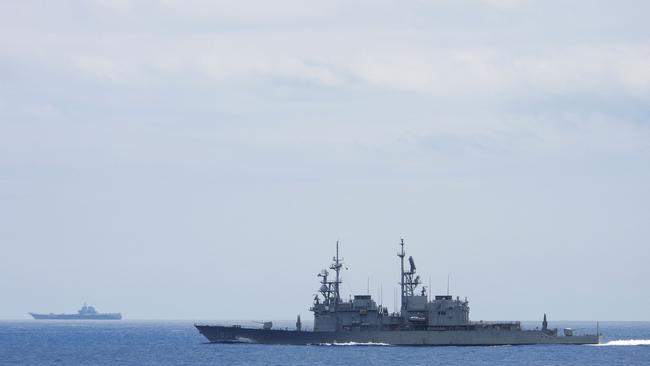China’s fighters aren’t just flying around Taiwan. They’re practising
Surge in activity shows Chinese honing ability to block US military from responding to an invasion.

China has sent some of its largest swarms of jet fighters and warships into the air and waters around Taiwan this month.
They have been accompanied by an unusual silence.
While previous Chinese drills of similar scale were paired with waves of propaganda meant to intimidate the self-ruled island, Beijing has said next to nothing about the recent exercises.
That silence is a sign that the recent activity is less about delivering a political message, Taiwanese authorities and defence analysts say, than about training. China’s military is trying to sharpen its ability to encircle Taiwan, neutralise the island’s natural advantages and block the US from coming to the rescue in the event of an invasion. Communist party leaders in Beijing regard Taiwan as part of China and have vowed to take control of it, by force if necessary.
During one day earlier this week, Taiwan’s military detected 103 Chinese military aircraft in areas around the island, a recent high, including 40 that entered the island’s air-defence identification zone. The next day 55 Chinese aircraft flew sorties near Taiwan, the Taiwanese Defense Ministry said.
Earlier this month, a Chinese aircraft carrier and around two dozen warships, an unusually large grouping, sailed southeast of Taiwan in the Western Pacific.
Notably, the Chinese sorties have included an increasing number of Y-20 transport and refuelling aircraft flying alongside jet fighters to the east of Taiwan. That suggests an intensified focus on improving the fighters’ long-range combat capabilities, military analysts said.
Taipei has long considered geography one of its greatest advantages in the event of a Chinese invasion, with a steep spine of mountains forming a natural barrier to enemy troops marching over from the west. For years, the Taiwanese military’s strategy has been to maintain a stronghold on the east coast, where it hoped to hold out long enough for the US to send help.
The presence of U.S. forces in waters surrounding Taiwan would add to the territorial and operational constraints that already make the invasion scenario challenging for the Chinese military. So the People’s Liberation Army, as China’s military is known, has made a priority of blocking a U.S. response, a strategy called “anti-access/area denial,” or A2/AD.
“They’re getting better, and I think this drill is kind of proof that they’re trying,” said Ben Lewis, an independent military analyst based in Washington, D.C. who has been tracking daily PLA activities for almost two years.
“We will surely study the PLA’s likely courses of action and plan for proper response measures,” said Maj. Gen. Sun Li-fang, a spokesman for Taiwan’s Ministry of National Defence. “The closer the PLA’s aircraft are to Taiwan, the stronger our countermeasures will be.” Taiwan’s military has tracked an increasing number of Chinese fighter jets and drones on the east side of the island, suggesting the PLA is expanding its ability to encircle the island. That puts key military and civilian infrastructure at risk of attack, said Shen Ming-shih, a director and research fellow at the Taiwanese military-backed Institute for National Defense and Security Research.
Shen pointed to Taiwan’s coming fleet of advanced F-16V jet fighters. In the past they could be safely stationed at bases near the eastern cities of Hualien and Taitung, he said, but the PLA air force’s work to expand its range “means the Chinese can actually bypass to the east of Taiwan to launch attacks on these key bases.” Chinese jet fighters don’t have enough range to engage in extended operations on Taiwan’s east coast, according to military analysts, which is where the Y-20s come in. Lately, the PLA has arranged for fighter units to take turns conducting refuelling operations with the transport jets, according to Chieh Chung, an associate research fellow with the National Policy Foundation, a Taipei-based think tank affiliated with the Chinese Nationalist Party.
The PLA sent three of the transport aircraft on extended flights to the southeast of Taiwan on Sept. 13, and two more again on Sunday, according to Taiwan’s Defence Ministry.
China still has a long way to go before it can deal with the U.S. military’s arriving in force, especially given Taiwan’s relatively advanced air-defence systems, said Lewis, the Washington-based analyst.
“They need to do a lot more of these drills before I would say that they’re really in a position to realistically threaten the United States’ ability to intervene in the conflict in the Taiwan Strait,” he said.
But the PLA’s capacity to deny the U.S. access is expected to improve significantly when a 1000-foot Chinese aircraft carrier, the Fujian, enters service in 2025, according to Taiwan’s Defense Ministry.
The large group of ships that China sent into the Western Pacific recently included the Shandong, its first domestically built aircraft carrier, according to Taiwanese and Japanese authorities. A large number of Chinese warships have also been spotted near the Yellow Sea and in the South China Sea, according to a senior Taiwanese security official briefed on the activity.
Some of that movement may be intended to demonstrate to the US that the PLA is comfortable operating beyond what it refers to as the “first island chain”, a stretch of islands including the Japanese archipelago, Taiwan and the Philippines that separates China from the broader Pacific, the Taiwanese official said.
The Wall Street Journal



To join the conversation, please log in. Don't have an account? Register
Join the conversation, you are commenting as Logout